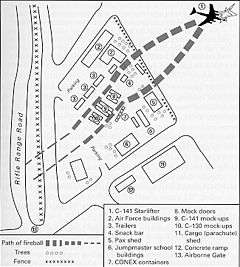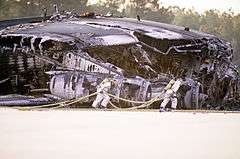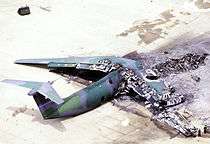Green Ramp disaster
|
Wreckage of the C-141 Starlifter destroyed by the accident. | |
| Accident summary | |
|---|---|
| Date | March 23, 1994 |
| Summary | Mid-air collision |
| Site |
Pope AFB, North Carolina, U.S. |
| Total fatalities | 24 (on ground) |
| Total injuries (non-fatal) | over 100 |
| First aircraft | |
| Type | F-16D |
| Operator | U.S. Air Force |
| Registration | 88-0171 |
| Crew | 2 |
| Survivors | 2 |
| Second aircraft | |
| Type | C-130E |
| Operator | U.S. Air Force |
| Registration | 68-10942 |
| Third aircraft | |
| Type | C-141B |
| Operator | U. S. Air Force |
| Registration | 66-0173 |
The Green Ramp disaster was a 1994 mid-air collision and subsequent ground collision at Pope Air Force Base in North Carolina. It killed twenty-four members of the U.S. Army's 82nd Airborne Division preparing for an airborne operation.[1][2][3] It was the worst peacetime loss of life suffered by the division since the end of World War II.
Crash
The "Green Ramp" is the large north-south parking ramp at the west end of Pope AFB's east-west runway, used by the U.S. Army to stage joint operations with the Air Force. Several buildings sit along its western edge, including Building 900, the building housing the Air Force operations group. A personnel shed ("pax shed", a large open-bay building) sat next to Building 900, which the Army used to prepare troops for parachute drops. A large grassy area, where troops could stage before drops, lay between the two buildings. Behind the area, several concrete mock-ups of the backs of Air Force cargo aircraft had been constructed, where troops could rehearse their drop procedures.
On the day of the accident, about 500 paratroopers from adjacent Fort Bragg were in the pax shed, the concrete mock-ups or resting in the grassy area. The personnel came from three division units, the First Brigade Combat Team, 504th Infantry Regiment, and 505th Infantry Regiment. While the jumpers prepared to board several C-130 and C-141 aircraft parked on Green Ramp, the sky was filled with F-16, A-10, and C-130 aircraft conducting training.[4]
Mid-air collision
Shortly after 1400 hours on Wednesday, March 23, 1994, a twin-seat F-16D (AF Ser. No. 88-0171, c/n 1D-25, of the 74th Fighter Squadron, 23rd Operations Group) with two pilots on board was conducting a simulated flameout (SFO) approach when it collided with a C-130E, (AF Ser. No. 68-10942, c/n 4322, of the 2nd Airlift Squadron, 317th Group). Both aircraft were members of the 23rd Wing, which was a tenant wing at Pope AFB at the time. The aircraft were on short final approach to runway 23 at an altitude of about 300 feet (90 m) above ground level. The nose of the F-16 severed the C-130's right elevator. On impact, the F-16 pilot applied full afterburner to try to recover the aircraft, but the aircraft began to disintegrate, showering debris on the runway and a road that ran around it. Both F-16 crewmembers ejected, but their aircraft, still on full afterburner, continued on an arc towards Green Ramp. At the same time, the C-130 crew took their aircraft away from the airfield and checked to ensure it could safely land. While the C-130 crew knew they were most likely struck by the F-16, they had no idea how it happened or the extent of the damage. After performing their checks, the crew returned to Pope and landed on the debris-littered runway.
Ground collision

and the path of the fireball
By the time the C-130 landed, the F-16 had hit Green Ramp heading west. The aircraft struck the ground in an empty parking place between two Air Force C-130s with crews on board preparing the aircraft for departure. When the F-16 hit the ground, its momentum carried the wreckage westward through the right wing of a C-141B (AF Ser. No. 66-0173 of the 438th Airlift Wing, McGuire Air Force Base, New Jersey) parked on the ramp. The C-141 crew was also preparing the aircraft for joint Army-Air Force operations, however, no Army troops besides the jumpmaster team had yet boarded the plane. The wreckage of the F-16 punctured the fuel tanks in the C-141's right wing, causing a large fireball, which combined with the F-16 wreckage and continued on a path taking it between Building 900 and the pax shed, directly into the area where the mass of Army paratroopers were sitting and standing. Twenty-three men died and over 80 were injured;[5] one severely burned paratrooper died over nine months later, on 3 January 1995.
Paratroopers at the scene pulled troopers from the flames and the exploding 20 mm ammunition from the F-16.[5] First upon the scene were vehicles and medics from the Army Delta Force, which is adjacent to Green ramp. Numerous US Army tactical ambulances with medical teams were immediately dispatched from the 55th Medical Group to ferry the injured to Womack Army Medical Center before civilian first responder vehicles arrived. These medics were among the first upon the scene and provided assistance after notification to MSG Richard Young of the 44th Medical Brigade Operations at Fort Bragg by a cell phone call from SFC Juan Gonzales at HQ, 44th Medical Brigade who was awaiting an airborne jump at Pope AFB.[6]
Aftermath

President Clinton visited the site two days after the incident and met with the injured at Womack at Fort Bragg.[7] Several of the more severely burned victims were taken to the U.S. Army Institute of Surgical Research at Brooke Army Medical Center, Texas.[2] Two months after the accident, only one paratrooper remained critical, while the others were either in satisfactory condition or convalescing at home.
A subsequent U.S. Air Force investigation placed most of the blame for the accident on the military and civilian air traffic controllers working Pope air traffic that day.[8] One of the enlisted controllers was later subject to Article 15 action. A later investigation, however, stated that pilot error by the F-16 pilots also contributed to the mishap, but no disciplinary action was taken against the pilots.
References
- ↑ Dalesio, Emery P. (March 24, 1994). "16 killed when F-16, C-130 collide at Pope". Wilmington Morning Star. Associated Press. p. 1A.
- 1 2 Thompson, Estes (March 25, 1994). "Crash death toll is at 20". Wilmington Morning Star. Associated Press. p. 1B.
- ↑ Brooks, Drew (May 23, 2014). "Survivors mark 20-year anniversary of Pope Air Force Base Green Ramp crash". Fayetteville Observer. Retrieved June 16, 2014.
- ↑ Quillin, Martha, "'It did not defeat us': Fort Bragg remembers deadly Green Ramp disaster", The News & Observer, (reprinted in the Stars and Stripes), 24 March 2014
- 1 2 "Some at crash were hit by ammo from fighter jet". Wilmington Morning Star. Associated Press. March 26, 1994. p. 3B.
- ↑ MSG Young and SFC Gonzales, 44th Med Bde FY 1994 Annual Report
- ↑ "Clinton meets with victims". Wilmington Morning Star. Associated Press. March 26, 1994. p. 1A.
- ↑ Schafer, Susanne M. (January 18, 1997). "Air Force to dig deeper into crash at N.C. base". Wilmington Morning Star. Associated Press. p. 3B.
External links
- Condon-Rall, Mary Ellen (1996). Disaster on Green Ramp: The Army's Response. Washington, D.C.: United States Army Center of Military History.
- Pope Air Force Base, NC "Green Ramp Disaster" Jet And Transport Collide, Mar 1994, GenDisasters.com.
- U.S. Army: The Heroes of Green Ramp
- LaRaia, Becky J. "Base recalls teamwork following ramp horror". Air Force Link, 2004-03-25.
- General Assembly of North Carolina, Senate Joint Resolution 1100 (1995): A Joint Resolution Honoring the Contributions of the 82nd Airborne Division and Remembering the Twenty-Four Paratroopers from the 82nd Airborne Division Who Lost Their Lives During a Routine Training Mission
- Hull-loss description at the Aviation Safety Network
Coordinates: 35°10′05″N 79°01′30″W / 35.168°N 79.025°W
